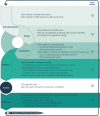Considerations for addressing bias in artificial intelligence for health equity
- PMID: 37700029
- PMCID: PMC10497548
- DOI: 10.1038/s41746-023-00913-9
Considerations for addressing bias in artificial intelligence for health equity
Abstract
Health equity is a primary goal of healthcare stakeholders: patients and their advocacy groups, clinicians, other providers and their professional societies, bioethicists, payors and value based care organizations, regulatory agencies, legislators, and creators of artificial intelligence/machine learning (AI/ML)-enabled medical devices. Lack of equitable access to diagnosis and treatment may be improved through new digital health technologies, especially AI/ML, but these may also exacerbate disparities, depending on how bias is addressed. We propose an expanded Total Product Lifecycle (TPLC) framework for healthcare AI/ML, describing the sources and impacts of undesirable bias in AI/ML systems in each phase, how these can be analyzed using appropriate metrics, and how they can be potentially mitigated. The goal of these "Considerations" is to educate stakeholders on how potential AI/ML bias may impact healthcare outcomes and how to identify and mitigate inequities; to initiate a discussion between stakeholders on these issues, in order to ensure health equity along the expanded AI/ML TPLC framework, and ultimately, better health outcomes for all.
© 2023. Springer Nature Limited.
Conflict of interest statement
M.D.A. reports the following conflicts of interest: Digital Diagnostics, Inc, Coralville, Iowa: Investor, Director, Consultant; patents and patent applications assigned to the University of Iowa and Digital Diagnostics that are relevant to the subject matter of this manuscript; Chair Healthcare AI Coalition, Washington DC; member, American Academy of Ophthalmology (AAO) AI Committee; member, AI Workgroup Digital Medicine Payment Advisory Group (DMPAG) of the American Medical Association. Z.O. reports the following conflicts of interest: Chief Scientific Officer, Dandelion Health. None of the other authors report conflicts of interest.
Figures
References
-
- U.S. Department of Health and Human Services HRaSA, Office of Health Equity. Health Equity Report 2019-2020. https://www.hrsa.gov/sites/default/files/hrsa/health-equity/HRSA-health-... (2020).
Publication types
LinkOut - more resources
Full Text Sources
Other Literature Sources


